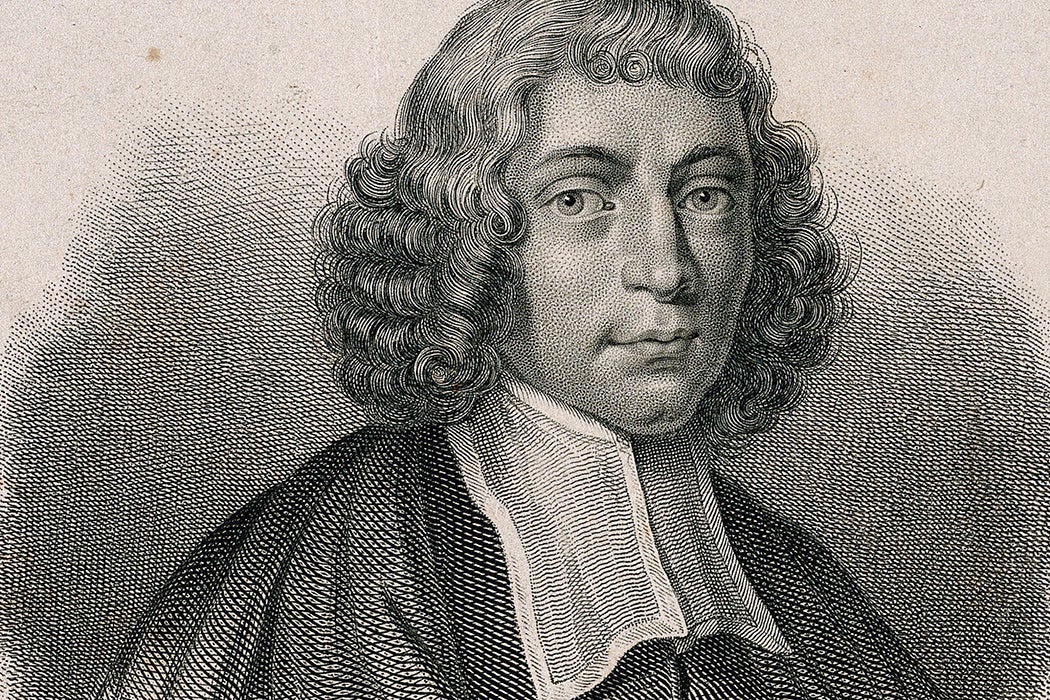When news spread from The Hague, in February 1677, that the lens-grinder and philosopher Spinoza was dead at the age of 44, the struggle over his legacy began. On one side were a small circle of friends and fellow religious/political/philosophical radicals. On the other, the combined weight of church and state—or rather, churches and states, because Spinoza already had a notorious reputation outside the Dutch Republic as well as within it.
Spinoza’s Tractatus theologico-politicus (1670), which dared to apply historical and linguistic methods to what he argued was not “holy” scripture, especially enraged the religious. He was condemned as a monstrously subversive freethinker and atheist by his own community of Orthodox Portuguese (Sephardic) Jews (who had excommunicated him), by the Orthodox Calvinists of the Dutch Republic, by Lutherans in neighboring states, and by Catholics everywhere.
While his friends raced to publish his Opera Posthuma, agents of Orthodoxy moved to suppress his works. As it happened, the Posthumous Works was published before the year was out—but the publisher took pains to leave Spinoza’s name and city off the edition, listing the author simply as “B. d. S.” The collection included Spinoza’s long-delayed magnum opus, Ethics.
Known variously as Baruch, Bento, and Benedictus (de) Spinoza, he wasn’t really an atheist. He identified God with nature, so “pantheist” might be a better description. But such subtly was lost on all the theologians. Spinoza was very much a radical within his—and all—fundamentalist times: an early democrat against priestly classes and so-called royal houses, he denied that Moses authored the Torah, denied that the Bible was unerring, denied that the Trinity was a thing, and denied that Christ was divine. Above all, he argued against superstition and ignorance, mindsets he considered fundamental to control by the priestly/princely.
As translated through Locke and Hume, Spinoza is one of the philosophical founts of the American Revolution. Via the Radical Enlightenment, he was one of the early sparks of the French Revolution. But all that came in the next century.
As Dutch philosopher Wiep van Bunge explains, it was the posthumous crafting of Spinoza’s life that helped preserve his name, allowing his work to live on and be re-discovered time and again. Spinoza’s supporters marketed him as the epitome of the philosopher—paving the way for the radical work itself. By the start of the eighteenth century, even his enemies, of which there were many, had to concede he was first and foremost a serious philosopher, worthy of being argued with, as opposed to just a “renegade Jew,” atheistic libertine, or one of the damnable “children of darkness.”
“They created a life of Spinoza,” writes van Bunge, “the essence of which was never seriously questioned by later biographers—a life revolving entirely around his works. Here was a man, or so Spinoza’s first editors wanted posterity to believe, whose life was entirely devoted to the pursuit of truth.”
Spinoza’s first generation of allies were friends and correspondents; they worked to portray him as “a thoroughly decent and sociable human being.” They do not seem to have forced him to fit the role: Spinoza, whom Bertrand Russell called “the noblest and most lovable of the great philosophers,” should be on everybody’s “invite X guests from history for dinner” list.
Atheists were not supposed to be virtuous, yet, as one English anti-Spinozist admitted, Spinoza himself “was truly sober, observant of the Laws of his Country, and not possest [sic] with the sordid Passion of heaping up Riches.”
Weekly Newsletter
In fact, the most important early Spinoza biographers, Pierre Bayle and Johann Köhler (a.k.a. Colerus) actually rejected Spinoza’s views but “admired his moral character.” Bayle’s extraordinarily influential Dictionnaire Historique et Critique (Historical and Critical Dictionary, 1697, 1702; English translation 1709) attempted to refute Spinoza’s ideas. But, by conceding that philosophical atheism was debatable, Bayle gave Spinoza respectability. And that was some respectability: the massive, six-million-word Dictionnaire has been called the “Arsenal of Enlightenment.” Colerus’s 1705 Spinoza biography was later repackaged in a key text of the French Radical Enlightenment, and translated into German twice.
“It is right to detest his atheism, but wrong to be-lie his character,” wrote Voltaire some nine decades after Spinoza’s death, “This must be owned. Do not let us, while we condemn, calumniate him.” But conceding that Spinoza was a nice guy only made his thorny ideas more potent. They couldn’t separate the philosopher from the philosophy, the life from the legacy.
Teaching Tips
Explore Primary Sources:
- Spinoza, Tractatus theologico-politicus (Latin) (English)
- Spinoza, Tractatus politicus (English)
- Spinoza, Opera Posthuma (Latin)
- Spinoza, Ethics (English)
- Pierre Bayle, Dictionnaire Historique et Critique (Abridged English, Vol. 1, 2, 3, 4 )
Learn more about the printing of Spinoza’s works in Printing Spinoza: A Descriptive Bibliography of the Works Published in the Seventeenth Century (2022)







